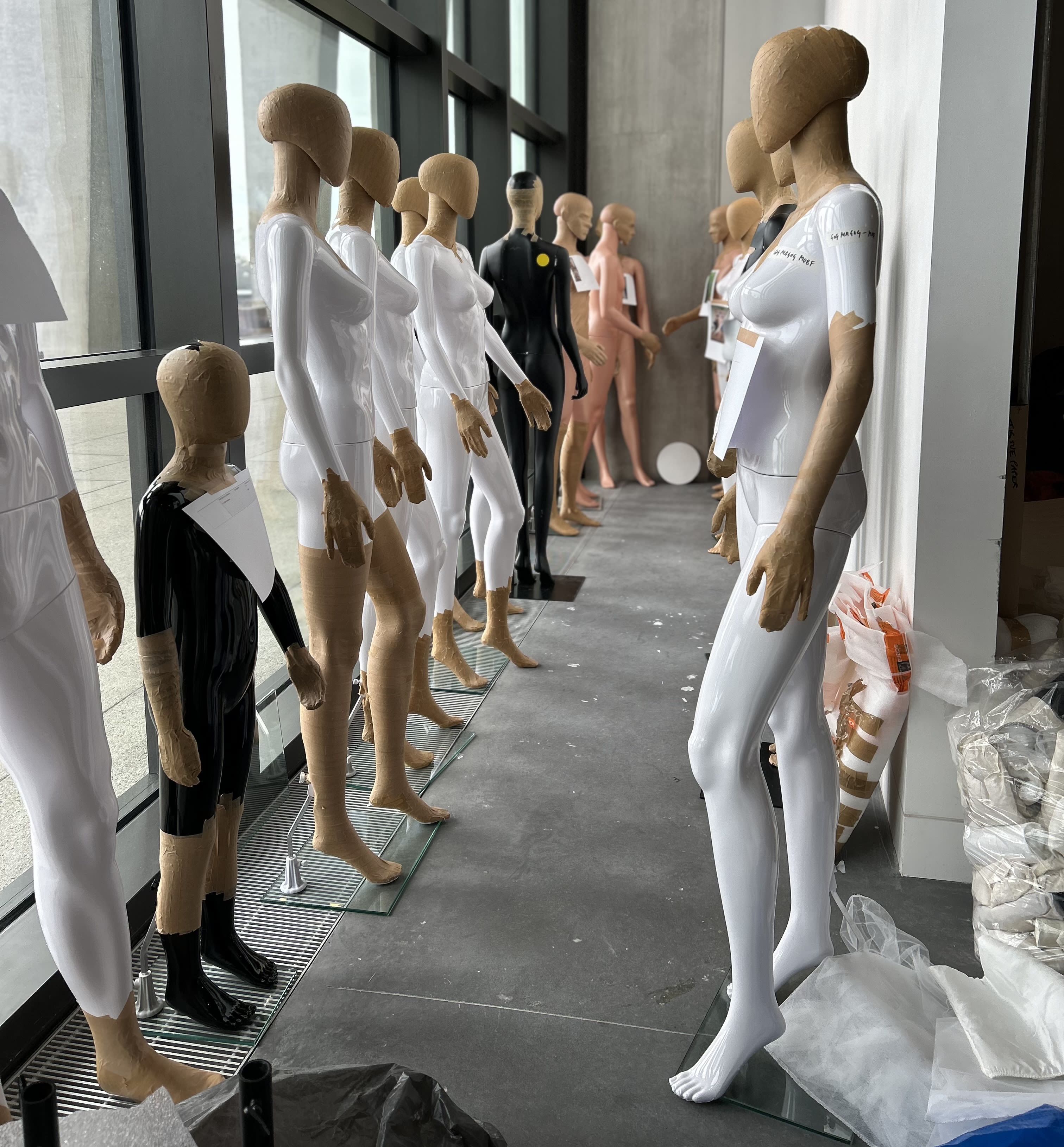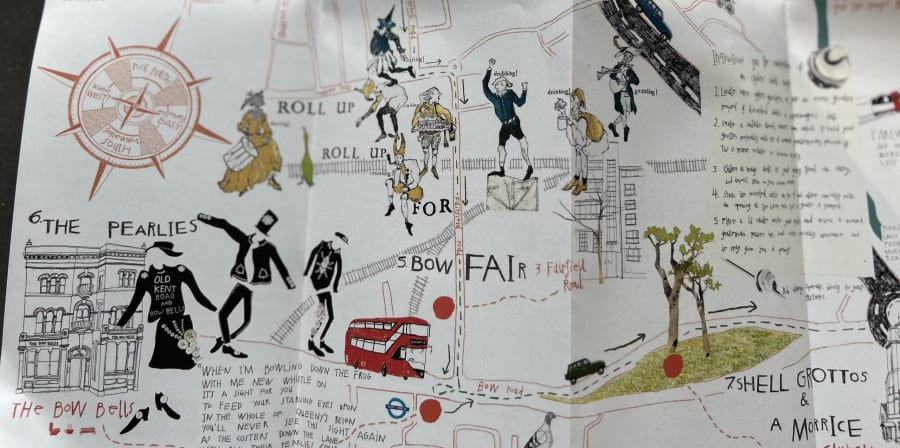
Behind the Scenes of Making More Mischief

- Written byAmy de la Haye, Centre for Fashion Curation
- Published date 15 April 2024

Curated by Simon Costin, Mellany Robinson and Amy de la Haye, working closely with the CfFC team and Cultural Programming
The Making Mischief: Folk Costume in Britain project was brought to LCF by Amy de la Haye, joint director of UAL’s Centre for Fashion Curation. It is a collaboration with Simon Costin (director) and Mellany Robinson (projects manager) of the Museum of British Folklore (MoBF). Working with Compton Verney (where the show was first staged in 2023) and MoBF, CfFC led a funding bid which secured £249 000 funding from the National Lottery Heritage Fund to present two exhibitions, events, workshops and an oral history programme exploring historical and contemporary British folk costume. The project has been managed by Dr Ben Whyman (manager, CfFC) and administered by Bre Stitt (administrator, CfFC) in close collaboration with Lindsay Pentelow, Head of Cultural Programming, along with the wider CP team.
The LCF exhibition, titled Making More Mischief and open now in the LCF galleries, East Bank, features nine London-based folk communities not displayed in the Compton Verney iteration. Two installations produced by Cultural Programming Producers Mirren Kessling and Dr Leila Nassereldein explore folk customs, both historical and contemporary, of Numbi Arts and Pxssy Palace. As part of CfFC’s deliverables, acclaimed film maker Ruth Hogben edited filmmaker Doc Rowe’s rare footage of British folk customs taken over the last 20 years, creating a thrilling immersive experience.
Mannequinage by Gesa Werner, formerly a V&A conservator, for Larry Golding's Pearly large size suit


Mannequinage by Gesa Werner, formerly a V&A conservator for Larry Golding's Pearly large size suit
.
Richard Sleeman and Bettina Fernandez-Sleeman, Hackney Paracarnival


Hackney Paracarnival was established in 2010 by Richard Sleeman and Bettina Fernandez-Sleeman. The duo creates costumes with and for people with disabilities. Kathleen Jackson works with them daily. She made the pom poms for the seated figure which has a face that resembles hers made by Richard. She was of course duly credited on the label.
Exhibiting dress is a highly skilled – and can be a greatly contested – practice. CfFC are members of the Museum Association (MA) and the International Council of Museums (ICOM); they adhere to internationally agreed guidelines on the care and display of objects. We regularly work with Gesa Werner, a highly talented former V&A dress costume mounting specialist, to prepare mannequins to support and best display garments. Her highly detailed and rigorous work for Making More Mischief was supported by Ben Whyman. As with all our projects, we worked closely with our communities to ensure their costumes were displayed and interpreted as they wished. Lenders were invited into the gallery spaces to help display their costumes. Wherever possible it is their voices (oral and textual) which provides the interpretation.
Mouliaye the Lion of Sengal, Yaram Arts, Hackney Carnival

Mouliaye installed his lion costume and painted his distinctive face mask, created as part of Yaram Arts, Hackney Carnival.
Mahogany Carnival Arts

Mahogany Carnival Arts is a group of multi-disciplinary artists who design and create large scale kinetic sculptures/carnival costumes for ‘Mas making.’ It was formed by Clary Salandy, shown installing here, and structural engineer Michael Ramdeen. This costume was created with local school children. This is the label:
Mahogany Carnival Arts, ‘Windrush Legacy (The Little Ship)
This design expresses the importance of passing on cultural traditions to the next generation. The theme commemorates the arrival of The Empire Windrush in 1948, highlighting the tremendous value and contribution the migrants made to the rebuilding and economic development of Great Britain.
The people of the African Caribbean diaspora have always been at the heart of generating the wealth of Great Britain through slavery, colonialism, and migration. Today, Caribbean people continue to work within the key industries that drive Britain’s global status.
We stand in solidarity with The Windrush Generation. - Mahogany Carnival Design
Doreen Golding, Pearly Queen of the Old Kent Road and Bow Bells

The East Bank vitrines (in the lower ground floor corridor) display seven installations making up ‘Pearly Passage’, exploring the lost heritage of East London’s pearl button industry. Four of these installations trace objects found by modern day mudlarkers on the banks of the river Thames, Pearly dolls, a large painting and a lithograph, ceramics, book and photographs. Amy de la Haye invited students from MA Fashion Womenswear (led by Dr Nabil el-Nayal) to provide three installations responding to these histories and objects. Amy worked closely with the students to curate three vitrines that communicated their own personal narratives in relation to Pearly culture. This space also hosts a film titled ‘Tabanca’ by acclaimed multidisciplinary filmmaker, writer and video artist Akinola Davies. The vitrines and film combined provide a dynamic interface between East and West London, lost and living heritage.

Mapping More Mischief



CfFC’s research assistant Laura Thornley, who has an MA in museum studies, conceived and produced ‘Mapping More Mischief’, an audio walking tour designed by UAL alum, illustrator Rosa Thorlby.
An oral history programme, led by experienced Oral Historian Julia Letts and administered by Bre Stitt and Milly Patrzalek, oversaw the training of 20 oral history volunteers. They captured oral testimonies from 29 folk participants, including: Bettina from Hackney Paracarnival; Kinsi Abdullah of Numbi Arts; Mattie Faint aka Mattie the Clown; and Doreen Golding, Pearly Queen of the Old Kent Road and Bow Bells.
As the exhibition was being installed, the team supported an inspirational Spring School programme led by Michele Buchanan and her team from UAL Outreach. The school guided over 90 students in experiences of making fashion toiles and textiles inspired by the exhibition’s themes. We provided folk objects for them to draw and offered special behind the scenes tours for the students with guidance on the curatorial installation process.
Detail of Whiteface clown costume, Maison Vicaire, Paris, 1930s

Detail of Whiteface clown costume, Maison Vicaire, Paris, 1930s. Courtesy of Clowns International and Clowns Gallery Ltd., Mattie Faint aka Mattie the Clown.
Projects like Making Mischief always inspire future collaborations and opportunities for future projects that offer a legacy. Before the exhibition opened, CfFC were asked to support an exhibition being staged by Hackney Carnival. We have offered to help carnival costume designer Clary Salandy place her archive in London museums; and we are working with Matti Faint, supporting him in a funding application to conserve the 1930s clown costume. Through this project, MoBF have secured donations and acquisitions of a number of folk costumes; we hope the London exhibition will inspire folk participants to donate further costumes to the Museum’s collection. The oral history project inspired many volunteers to further their research and careers in the practice, capturing the very special stories of folk customs in the UK. Our long-term goal is to help MoBF secure a permanent venue and support their museums’ accreditation process with the Museums Association.
Amy, Mellany and Simon are now working on a series of NHLF funded exhibitions (2024-26) for Wessex Museums called ‘Un/Common People: Folk Culture in Wessex.’